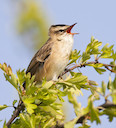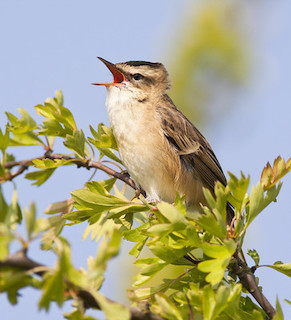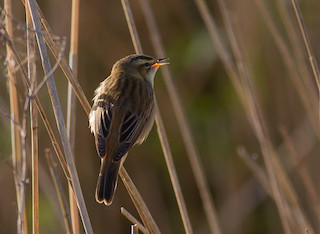 A summer visitor to Britain from Africa, Windmill Farm is a good place to spot Sedge Warblers.
A summer visitor to Britain from Africa, Windmill Farm is a good place to spot Sedge Warblers.
Photo: © Natural England/Allan Drewitt
Scientific name: Acrocephalus schoenobaenus
Conservation status: IUCN Red List, Least Concern
What to look for:
- Colouring and appearance: Black-streaked sandy brown upper parts and cream underparts, a prominent cream stripe above the eye, grey-brown legs.
- Size: Wingspan of 19 cm, body length of 13 cm.
- Where: Marshes or reedbeds, usually with some shrubs (such as willow) on which they can perch. The summer distribution includes much of Europe and parts of Asia, as well as Britain, but all these breeding populations overwinter in sub-Saharan Africa.
- Call: A rather rambling, often complex warble.
- Similar species: The Reed Warbler has no streaking; the Aquatic Warbler, a scarce migrant in the autumn to southern parts of Britain, is more heavily streaked and more yellow-brown in colouring.
 Sedge Warblers can be found across Britain in the summer, having arrived here from their overwintering home to the south of the Sahara: Britain hosts over 250,000 breeding pairs in the summer (source: BTO, 2009). The males arrive first in the spring in order to stake out their territories. Watch out for them near marshy, damp areas or reedbeds, singing loudly from a prominent perch on a bush or reed in order to attract a mate. Dawn and dusk are the best times to see Sedge Warblers: this is their favourite food hunting time, when insects are more sluggish because of the cooler temperature.
Sedge Warblers can be found across Britain in the summer, having arrived here from their overwintering home to the south of the Sahara: Britain hosts over 250,000 breeding pairs in the summer (source: BTO, 2009). The males arrive first in the spring in order to stake out their territories. Watch out for them near marshy, damp areas or reedbeds, singing loudly from a prominent perch on a bush or reed in order to attract a mate. Dawn and dusk are the best times to see Sedge Warblers: this is their favourite food hunting time, when insects are more sluggish because of the cooler temperature.
In May or June, the female lays about five eggs near to water in a nest which incorporates grass, moss, horsehair and willow down. After the eggs have hatched, both parents help to feed the young, and will continue to supplement their food for about two weeks after the young birds have fledged.
Global numbers of Sedge Warblers are declining, probably due to drought in their wintering location in Africa.
 Did you know…?
Did you know…?
…Serenading: male Sedge Warblers mimic sounds, including the songs of Blackbirds and Blue Tits, and introduce them into their call. The males never repeat a song, and females go for males with more complex repertoires.
…Staying power: some Sedge Warblers are known to fly between Africa and Britain without stopping for a break, a journey of some 3,800 km.
More information and references:
Svensson, L., Mullarney, K., Zetterstrom, D.,1986. Collins Bird Guide, second edition (translated by Christie, D., Svensson, L.). HarperCollins, London.
Published: June 2014
Author: Amanda Scott
Photos: © Natural England/Allan Drewitt
